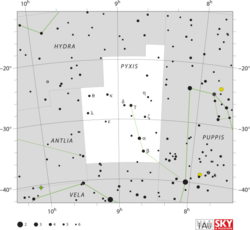Astronomy:Epsilon Pyxidis
| Observation data Equinox J2000.0]] (ICRS) | |
|---|---|
| Constellation | Pyxis |
| Right ascension | 09h 09m 56.41024s[1] |
| Declination | −30° 21′ 55.4460″[1] |
| Apparent magnitude (V) | +5.60[2] |
| Characteristics | |
| Spectral type | A4 IV[3] |
| U−B color index | +0.16[2] |
| B−V color index | +0.16[2] |
| Astrometry | |
| Radial velocity (Rv) | −9.7±0.3[4] km/s |
| Proper motion (μ) | RA: −1.93[1] mas/yr Dec.: −48.99[1] mas/yr |
| Parallax (π) | 15.39 ± 0.30[1] mas |
| Distance | 212 ± 4 ly (65 ± 1 pc) |
| Absolute magnitude (MV) | +2.00[5] |
| Details | |
| ε Pyx A | |
| Mass | 2.07[6] M☉ |
| Luminosity | 19[7] L☉ |
| Surface gravity (log g) | 3.26[8] cgs |
| Temperature | 6368±1806[8] K |
| Metallicity [Fe/H] | +0.04[8] dex |
| Rotational velocity (v sin i) | 108.3±0.3[9] km/s |
| Age | 560[6] Myr |
| Other designations | |
| Database references | |
| SIMBAD | data |
Epsilon Pyxidis (ε Pyxidis) is quadruple[11] star system in the southern constellation of Pyxis. It is faintly visible to the naked eye, having a combined apparent visual magnitude of +5.60.[2] Based upon an annual parallax shift of 15.39 mas as seen from Earth,[1] it is located around 212 light years from the Sun. The system is deemed to be a member of the Sirius supercluster of stars that share a common motion through space.[5]
The primary, component A, is a white-hued A-type subgiant star with a stellar classification of A4 IV.[3] It is a microvariable, showing a 0.0056 change in magnitude with a frequency of 0.16245 times per day.[12] Epsilon Pyxidis has been catalogued as an Am star,[2] although this remains uncertain.[13] It has double[6] the mass of the Sun and radiates 19[7] times the Sun's luminosity from its photosphere at an effective temperature of 6,368 K.[8]
In addition to a close companion of unknown type at an angular separation of 0.17 arc seconds, the primary shares an orbit with a binary star system, components B and C, that lie at an angular separation of 17.8 arc seconds. At the estimated distance of this system, this corresponds to a projected separation of around 1,150 AU.[6] The B/C pair consist of visual magnitude 10.5 and 10.8 stars with a mean separation of 0.3 arc seconds.[11] They have estimated mass of 90% and 95% that of the Sun, respectively.[6]
References
- ↑ 1.0 1.1 1.2 1.3 1.4 1.5 van Leeuwen, F. (2007), "Validation of the new Hipparcos reduction", Astronomy and Astrophysics 474 (2): 653–664, doi:10.1051/0004-6361:20078357, Bibcode: 2007A&A...474..653V.
- ↑ 2.0 2.1 2.2 2.3 2.4 Mendoza, E. E. et al. (June 1978), "UBVRI photometry of 225 AM stars", Astronomical Journal 83: 606–614, doi:10.1086/112242, Bibcode: 1978AJ.....83..606M.
- ↑ 3.0 3.1 Houk, Nancy (1979), Michigan catalogue of two-dimensional spectral types for the HD stars, 3, Ann Arbor, Michigan: Dept. of Astronomy, University of Michigan, Bibcode: 1982mcts.book.....H.
- ↑ de Bruijne, J. H. J.; Eilers, A.-C. (October 2012), "Radial velocities for the HIPPARCOS-Gaia Hundred-Thousand-Proper-Motion project", Astronomy & Astrophysics 546: 14, doi:10.1051/0004-6361/201219219, A61, Bibcode: 2012A&A...546A..61D.
- ↑ 5.0 5.1 Eggen, Olin J. (August 1998), "The Sirius Supercluster and Missing Mass near the Sun", The Astronomical Journal 116 (2): 782–788, doi:10.1086/300465, Bibcode: 1998AJ....116..782E.
- ↑ 6.0 6.1 6.2 6.3 6.4 De Rosa, R. J. et al. (2013), "The VAST Survey – III. The multiplicity of A-type stars within 75 pc", Monthly Notices of the Royal Astronomical Society 437 (2): 1216, doi:10.1093/mnras/stt1932, Bibcode: 2014MNRAS.437.1216D.
- ↑ 7.0 7.1 McDonald, I. et al. (2012), "Fundamental Parameters and Infrared Excesses of Hipparcos Stars", Monthly Notices of the Royal Astronomical Society 427 (1): 343–57, doi:10.1111/j.1365-2966.2012.21873.x, Bibcode: 2012MNRAS.427..343M.
- ↑ 8.0 8.1 8.2 8.3 Casagrande, L. et al. (2011), "New constraints on the chemical evolution of the solar neighbourhood and Galactic disc(s). Improved astrophysical parameters for the Geneva-Copenhagen Survey", Astronomy & Astrophysics 530 (A138): 21, doi:10.1051/0004-6361/201016276, Bibcode: 2011A&A...530A.138C.
- ↑ Díaz, C. G. et al. (July 2011), "Accurate stellar rotational velocities using the Fourier transform of the cross correlation maximum", Astronomy & Astrophysics 531: A143, doi:10.1051/0004-6361/201016386, Bibcode: 2011A&A...531A.143D.
- ↑ "eps Pyx". SIMBAD. Centre de données astronomiques de Strasbourg. http://simbad.u-strasbg.fr/simbad/sim-basic?Ident=eps+Pyx.
- ↑ 11.0 11.1 Eggleton, P. P.; Tokovinin, A. A. (September 2008), "A catalogue of multiplicity among bright stellar systems", Monthly Notices of the Royal Astronomical Society 389 (2): 869–879, doi:10.1111/j.1365-2966.2008.13596.x, Bibcode: 2008MNRAS.389..869E.
- ↑ Koen, Chris; Eyer, Laurent (2002), "New periodic variables from the Hipparcos epoch photometry", Monthly Notices of the Royal Astronomical Society 331 (1): 45–59, doi:10.1046/j.1365-8711.2002.05150.x, Bibcode: 2002MNRAS.331...45K.
- ↑ Renson, P.; Manfroid, J. (May 2009), "Catalogue of Ap, HgMn and Am stars", Astronomy and Astrophysics 498 (3): 961–966, doi:10.1051/0004-6361/200810788, Bibcode: 2009A&A...498..961R, https://zenodo.org/record/890529.
 |


